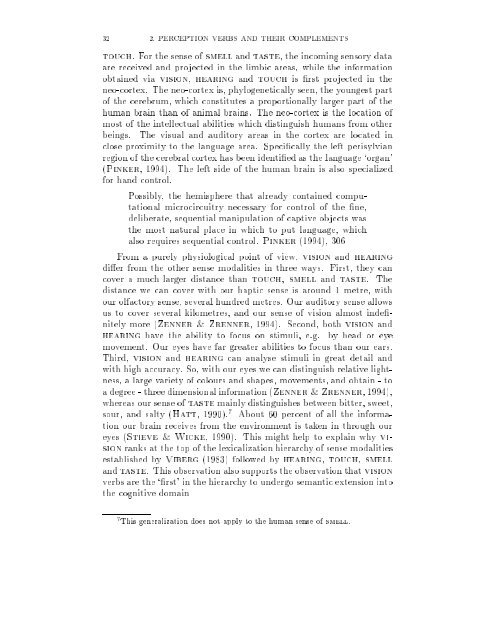Perception verb complements in Akatek, a Mayan language
Perception verb complements in Akatek, a Mayan language
Perception verb complements in Akatek, a Mayan language
Create successful ePaper yourself
Turn your PDF publications into a flip-book with our unique Google optimized e-Paper software.
32 2. PERCEPTION VERBS AND THEIR COMPLEMENTS<br />
touch. For the sense of smell and taste, the <strong>in</strong>com<strong>in</strong>g sensory data<br />
are received and projected <strong>in</strong> the limbic areas, while the <strong>in</strong>formation<br />
obta<strong>in</strong>ed via vision, hear<strong>in</strong>g and touch is rst projected <strong>in</strong> the<br />
neo-cortex. The neo-cortex is, phylogenetically seen, the youngest part<br />
of the cerebrum, which constitutes a proportionally larger part of the<br />
human bra<strong>in</strong> than of animal bra<strong>in</strong>s. The neo-cortex is the location of<br />
most of the <strong>in</strong>tellectual abilities which dist<strong>in</strong>guish humans from other<br />
be<strong>in</strong>gs. The visual and auditory areas <strong>in</strong> the cortex are located <strong>in</strong><br />
close proximity to the <strong>language</strong> area. Speci cally the left perisylvian<br />
region of the cerebral cortex has been identi ed as the <strong>language</strong> `organ'<br />
(P<strong>in</strong>ker, 1994). The left side of the human bra<strong>in</strong> is also specialized<br />
for hand control.<br />
Possibly, the hemisphere that already conta<strong>in</strong>ed computational<br />
microcircuitry necessary for control of the ne,<br />
deliberate, sequential manipulation of captive objects was<br />
the most natural place <strong>in</strong> which to put <strong>language</strong>, which<br />
also requires sequential control. P<strong>in</strong>ker (1994), 306<br />
From a purely physiological po<strong>in</strong>t of view, vision and hear<strong>in</strong>g<br />
di er from the other sense modalities <strong>in</strong> three ways. First, they can<br />
cover a much larger distance than touch, smell and taste. The<br />
distance we can cover with our haptic sense is around 1 metre, with<br />
our olfactory sense, several hundred metres. Our auditory sense allows<br />
us to cover several kilometres, and our sense of vision almost <strong>in</strong>de -<br />
nitely more (Zenner & Zrenner, 1994). Second, both vision and<br />
hear<strong>in</strong>g have the ability to focus on stimuli, e.g. by head or eye<br />
movement. Our eyes have far greater abilities to focus than our ears.<br />
Third, vision and hear<strong>in</strong>g can analyse stimuli <strong>in</strong> great detail and<br />
with high accuracy. So, with our eyes we can dist<strong>in</strong>guish relative lightness,<br />
a large variety of colours and shapes, movements, and obta<strong>in</strong> - to<br />
a degree - three dimensional <strong>in</strong>formation (Zenner & Zrenner, 1994),<br />
whereas our sense of taste ma<strong>in</strong>ly dist<strong>in</strong>guishes between bitter, sweet,<br />
sour, and salty (Hatt, 1990). 7 About 60 percent of all the <strong>in</strong>formation<br />
our bra<strong>in</strong> receives from the environment is taken <strong>in</strong> through our<br />
eyes (Stieve & Wicke, 1990). This might help to expla<strong>in</strong> why vision<br />
ranks at the top of the lexicalization hierarchy of sense modalities<br />
established by Viberg (1983) followed by hear<strong>in</strong>g, touch, smell<br />
and taste. This observation also supports the observation that vision<br />
<strong>verb</strong>s are the ` rst' <strong>in</strong> the hierarchy to undergo semantic extension <strong>in</strong>to<br />
the cognitive doma<strong>in</strong><br />
7 This generalization does not apply to the human sense of smell.

















